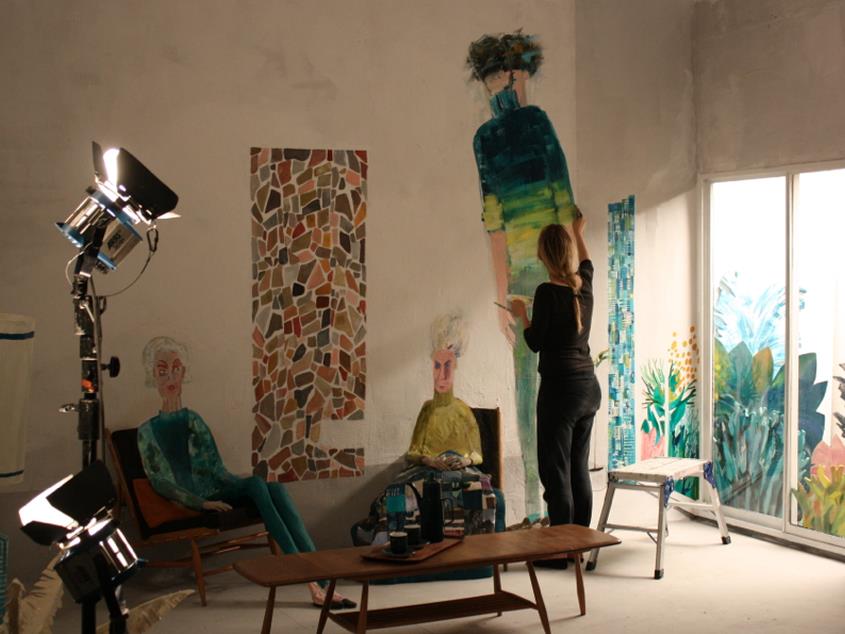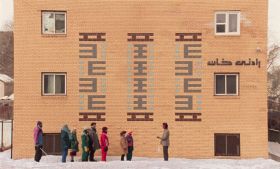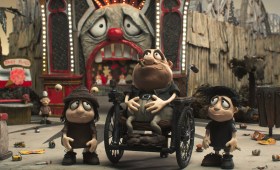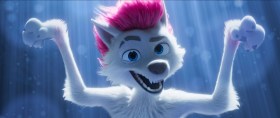Image: Daisy Jacobs at work on her animation, The Bigger Picture.
The St Kilda Film Festival Saturday Filmmaker Development Program was created in association with the various Guilds, who brought their own members and opened their crafts to a wider audience. Several sessions were full, and all of them were well attended, including the very esoteric session about Adobe Premiere.
The audience demonstrates that the industry is now very much wider than the traditional production opportunities of features and television. People with mainstream credits on IMDB were a small minority, particularly in the more technical sessions.
Although the film schools have traditionally used St Kilda as an opportunity to reveal their value – and RMIT was prominent this year – the current state of play lights up the anarchy option: Why go to film school at all, with its student debt and academic requirements? Both strategies can work, of course.
Ironically the Screen Resource Organisations, which are the natural glue between film school and a wider emerging creative community, are being shut down. They took another hit last week as Screen West announced it will absorb the Film and Television institute in Perth.
This is the third year for the St Kilda Festival in the pop-up cinema inside the St Kilda Town Hall. According to festival director Paul Harris, it is getting the best audiences ever for sessions, along with the most successful industry event. The cinema itself is cosy and friendly, with an enormous screen and fine illumination. The 1930’s seating arranged like a tennis bleacher is holding up well. The bar and lounge are buzzing.
The Vimeo session with Jeffrey Browers, who ScreenHub interviewed before he arrived, put the eight international shorts on the big screen. They are also available in full in beautiful resolution on Vimeo, so you too can watch them.
Read More: Vimeo gets more vim between toes of giants.
Harris asked Bowers that question about the need to go to film school, and he hesitated and changed the topic. Nearly every filmmaker in his selection is highly educated and two films are strongly supported by a school.
In a sense, no matter what the style or sensibility, one filmmaker from this collection speaks for everyone. Anson Fogel, an outdoorsy action-driven director who made When We Were Knights, has his own short biography on Vimeo.
“The spirit will come through’, he says.
OutsideTV ImageQuest Anson Fogel from Camp 4 Collective on Vimeo.
There is no evidence of a film school.
Here is the whole set. Give them time, put on your headphones. They are fabulous.
Say Something Intelligent
Lewis Bennett ‘makes weird documentaries’, and is building a series about British Columbia. This one is nothing more or less than a clever edit of his father’s home movies. He has been a freelance editor in Vancouver for nine years, and has an Intensive Program Certificate from the Gulf Islands Film and Television School, and has a FilmFLEX Industry Partnership Certificate from the British Columbia Institute of Technology.
He is interviewed on the Vimeo blog by Bowers:
The feature documentary, The Sandwich Nazi, that we made recently has been a fucking debacle so I’ve known for a while that I needed to make a couple of quick fun things to try to wash away the frustration of that project. We’ve also dumped a ton of money into the feature so I only want to make fun no-pressure DIY shorts for a while – the smaller, cheaper, and weirder – the better.
Say Something Intelligent from Lewis Bennett on Vimeo.
———–
Thunder Road
Officer Arnaud loved his Mom. Grand Jury Prize Winner at the 2016 Sundance Film Festival.
Jim Cummings has been a producer for five years, and went to school in Louisiana and graduated from Emerson College in Boston with a degree in film, cinema and video studies where he directed. He erupted suddenly as director, writer actor, dancer and bad singer with an extraordinary debut short. Yes, it is one shot.
Thunder Road from Jim Cummings on Vimeo.
And here is his background story. Also very nifty.
SUNDANCE 2016 from Jim Cummings on Vimeo.
Since then he has done another one shot drama which is a high octane catastrophe…
The Robbery from Jim Cummings on Vimeo.
——–
Territory
A beautiful observational documentary about the Barbary Apes in Gibraltar, hunted endlessly by government employees whose job is to disturb them with pea shooters. The pacing is gentle against the continuing startlement we get by creatures who see our urban landscape as a kind of jungle gym, darting up and down pipes and poles in defiance of the laws of gravity.
Eleanor Mortimer has a BA in French & Spanish, foreign languages and literatures, general, and an MA in documentary from the National Film and Television school where this film was made. She is now one third of Glow in the Dark Films.
She too was interviewed on the Vimeo blog.
‘I spent a five weeks in Gibraltar overall, which is also how we managed to capture what we did. If we were only there a week or two, this film would never have been possible. I had the time to observe before filming, and to allow things to unfold naturally. I feel very passionately that documentary making needs time, and wish budgets would reflect this. Real life doesn’t fit into tight schedules unless you force it, and if you force it, it isn’t real. We had three weeks in the edit, during which time we were working out sound and music as well. Nina and I worked really closely with sound designer Florentin Tudor and composer Fraya Thomsen to shape the film. They both pulled out all the stops to make it work.’
Territory from Eleanor Mortimer on Vimeo.
———
It’s A Date
Based on a true story, It’s a Date explores miscommunication, perceptions and vulnerability in the modern world. Everyone is an alien at first.
Animation director Zacahary Zezima is an independent in Los Angeles and New York, is doing well at festivals and is part of the Circle Line Projects collective. They like neon a LOT. He teaches at the prestigious Parsons School of Design in New York, where he also studied after the Californian Institute of the Arts, where he did experimental animation.
‘The writing process was the most difficult part of making this film because I was challenged with creating a somewhat natural conversation that always fed into the larger idea of the story. Almost every line corresponds to a hint of what’s really going on underneath the actual words being spoken. My original script and storyboard was about 15 minutes long, so after a lot of editing I got it down to about six and began production. The only problem was that once I started actually animating, I also started therapy and a new relationship and they both influenced my thinking so much that I ended up completely changing how the story unfolded. It became much more psychological, cerebral and nonlinear, while before it was more traditional. I threw away almost a full minute of completed scenes because of these last minute changes, but I think it was worth it. I find sacrifice to be really important in the act of creating.’
It’s a Date (2016) from Zachary Zezima on Vimeo.
The Bigger Picture
Using seven-foot-tall characters in life-size sets, The Bigger Picture tells the stark and darkly humorous tale of caring for an elderly parent.
Daisy Jacobs is a painter, animator and grandchild of painters too. Her extraordinary film is inspired by her grandmother’s dying days. She studied animation at Central Saint Martins School of art in London, followed by an MA at the National Film and Television School. This is her graduation film, for which she won a BAFTA for Best Animated Film. Her approach is beautifully described in The Guardian by Joanna Moorhead.
The Bigger Picture from daisy jacobs on Vimeo.
Her Vimeo interview gets into the nitty-gritty.
“The Bigger Picture” is my student film and so the budget for materials was very small. All the props came from boot sales, charity shops, and eBay — I had my whole family out there, haggling. Chris and I couldn’t animate the real props, of course, because they were too heavy or too solid. That meant every prop (every last teacup) had to be replicated in lightweight cardboard, and not just once but in multiples. We also had to make multiples of every arm, leg, hand, and foot for each character. We sat in a tiny room at the NFTS for weeks, with Chris making the cardboard multiples and me painting them. It was grindingly dull and quite creepy: we sat in the gloom, surrounded by bin bags of pale, severed limbs.’
.
MAKING OF for web from daisy jacobs on Vimeo.
Whale Valley
Guðmundur Arnar Guðmundsson is an Icelandic director supported by the Danish Film Institute, whose first film Whale Valley received a Special Mention at Cannes. He is part of Join Motion Pictures; Whale Valley is doing brilliantly at festivals; his first feature Heartstone is also hitting the circuit. He graduated in Fine Arts at the Iceland Academy of the Arts and went on to study screenplay in Denmark.
The story came to me like a poem, glimpses of emotions, moments, visuals and dreams that I wrote down and decided to make into a single story. I’ve had few friends that have taken their own lives so that is the reason why I wanted the film to partly deal with that subject. Also, growing up in Iceland, back then, it was considered a weakness for boys to show their emotions and I think that very much affected me. I learned to keep things in and my escape route became the nature that I would seek to mirror my emotions.
WHALE VALLEY from Join Motion Pictures on Vimeo.
No Film School has the story of the whale:
‘”In the script stage, everyone wanted to save me from the disappointment of not finding a whale,” Guðmundsson said. “My friends and colleagues tried to convince me to change it into a sheep, horse, cow, or basically any animal except a whale.”‘
He knew one arrived on an Icelandic beach each year on average and was set to wait. But it arrived even before they started the main shoot.
‘Though it was still winter at the time, the snow began melting the next day, leaving a mile-long lake in its wake. To Guðmundsson’s chagrin, it blocked the only road to the beach. But with the help of a local farmer, who cleared the lake by digging paths for over a week with his small Caterpillar, the crew was able to reach the whale.
“When we got to the whale, it was half buried into the beach, but the farmer was sure he could save that, as well,” said Guðmundsson. “He restored the whale and ended up playing an extra in the scene on top of that.”
The exquisite scene that resulted was well worth the trouble. “On the day of the shooting, there was a huge storm outside and we were all wet to the bone and freezing. But all the same, the visuals were amazing, so it was a mixed feeling of joy and pain.”‘
———
When We Were Knights
How can you express everything that you want to somebody you love, knowing that if you don’t, that might be the last opportunity that you have? That is a reality that we all face, but for BASE jumpers, the risk of death sometimes results in something amazing and unexpected – love.
Anson Fogel was basically a commercials and adventure film director, in love with storytelling, supported by GoPro and Camp4 Collective. Then someone died and I think he became a little more.
When We Were Knights from GoPro on Vimeo.
The Procedure
This film is a weird, fragmentary piece of fun. Proof that WTF can be done with beautiful lighting and a fine sense of style. Why try and explain it?
The Procedure from calvin reeder on Vimeo.
You can learn more about the director Calvin Lee Reeder here. He made a horror film in 2011 called The Oregonian followed by The Rambler. His films are described as ‘ a strange mix of psychological horror, high-minded surrealism, camp, and a soundtrack and filmic texture that hint at both nostalgia and discomfort.’
This selection of films covers a lovely range of approaches, from domestic joy to high art and adventure filmmaking. This final short short points to the endearing craziness at the edge of the cinema. Reeder’s two features have divided audiences so thoroughly they can be called the best and worst of possible movies by serious critics at the same screening.
According to MTV.com,
‘Based on Reeder’s 2008 short film of the same title, Mulroney plays “The Rambler,” a soft talking, sunglasses wearing, guitar carrying good ol’ boy whose just been released from prison and is trying to adapt to normal life. He’s picked up from jail by his slutty girlfriend (Lyonne) and returns to his old thrift store job, though the memories of his time in prison have changed him. Fed up with his life he leaves his wife and takes off to the dusty roads of Roswell, New Mexico. He quickly hitches a ride with an elderly man who says he’s a scientist and has a device that can look into people’s memories, which he then transfers onto VHS. Thus begins the madness as we’re hit with a barrage of striking images and weird encounters for the rest of the movie.’
Here is the trailer:
It all depends on what you want.





